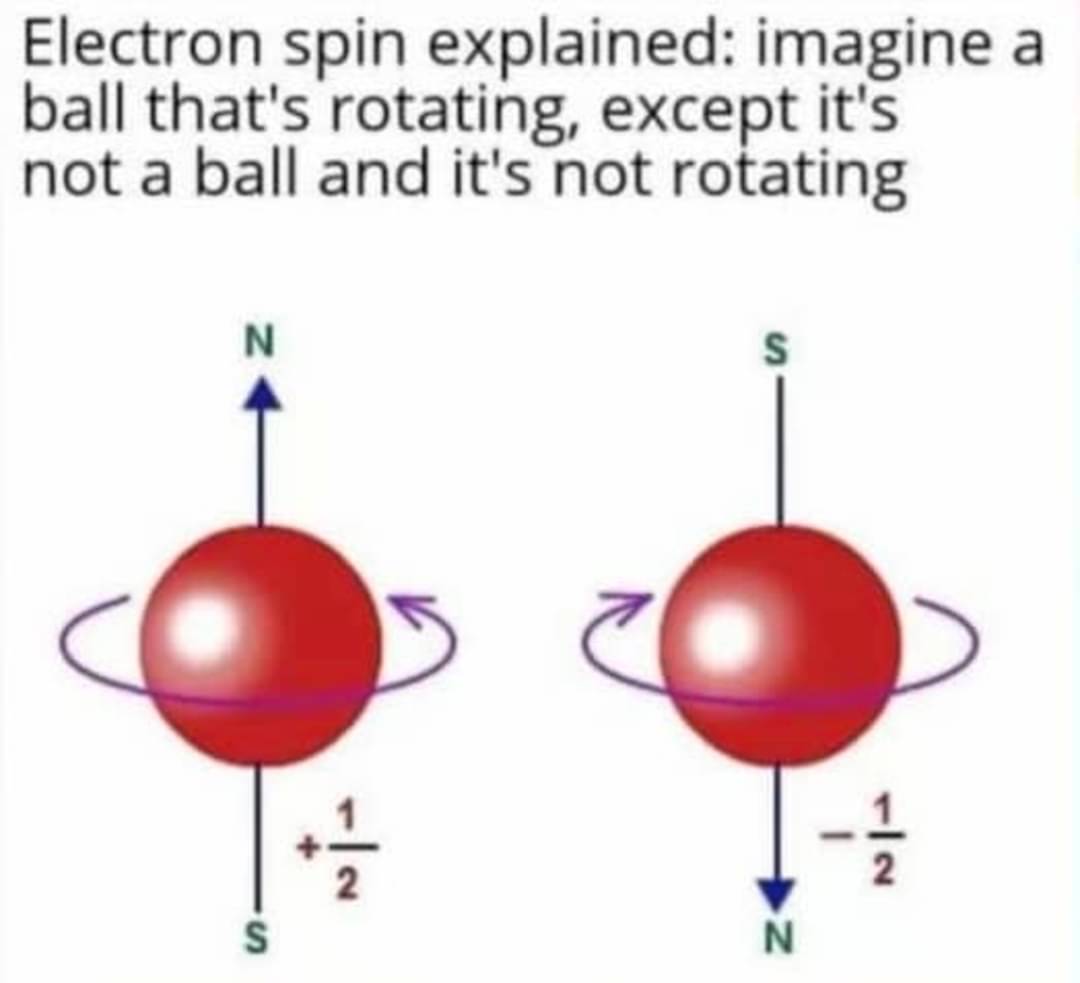this post was submitted on 11 Jul 2024
938 points (98.8% liked)
Science Memes
11086 readers
1648 users here now
Welcome to c/science_memes @ Mander.xyz!
A place for majestic STEMLORD peacocking, as well as memes about the realities of working in a lab.

Rules
- Don't throw mud. Behave like an intellectual and remember the human.
- Keep it rooted (on topic).
- No spam.
- Infographics welcome, get schooled.
This is a science community. We use the Dawkins definition of meme.
Research Committee
Other Mander Communities
Science and Research
Biology and Life Sciences
- !abiogenesis@mander.xyz
- !animal-behavior@mander.xyz
- !anthropology@mander.xyz
- !arachnology@mander.xyz
- !balconygardening@slrpnk.net
- !biodiversity@mander.xyz
- !biology@mander.xyz
- !biophysics@mander.xyz
- !botany@mander.xyz
- !ecology@mander.xyz
- !entomology@mander.xyz
- !fermentation@mander.xyz
- !herpetology@mander.xyz
- !houseplants@mander.xyz
- !medicine@mander.xyz
- !microscopy@mander.xyz
- !mycology@mander.xyz
- !nudibranchs@mander.xyz
- !nutrition@mander.xyz
- !palaeoecology@mander.xyz
- !palaeontology@mander.xyz
- !photosynthesis@mander.xyz
- !plantid@mander.xyz
- !plants@mander.xyz
- !reptiles and amphibians@mander.xyz
Physical Sciences
- !astronomy@mander.xyz
- !chemistry@mander.xyz
- !earthscience@mander.xyz
- !geography@mander.xyz
- !geospatial@mander.xyz
- !nuclear@mander.xyz
- !physics@mander.xyz
- !quantum-computing@mander.xyz
- !spectroscopy@mander.xyz
Humanities and Social Sciences
Practical and Applied Sciences
- !exercise-and sports-science@mander.xyz
- !gardening@mander.xyz
- !self sufficiency@mander.xyz
- !soilscience@slrpnk.net
- !terrariums@mander.xyz
- !timelapse@mander.xyz
Memes
Miscellaneous
founded 2 years ago
MODERATORS
you are viewing a single comment's thread
view the rest of the comments
view the rest of the comments

Sure. So, imagine a rectangular pool of water. You have a little weight on one end of the pool bobbing up and down producing waves. Then you put a wall halfway down the pool with two gaps in the wall. The waves from the wave-generator hit the gaps and go through. At the back wall of the pool you can measure the wave height. What you see is that at some points there are big waves, and at other point no waves at all. What's happening is that the waves coming through each gap travel different distances. If the wave from one gap is at a trough when the wave from the other gap is at a peak, they interfere with each-other and the water doesn't move much. If, instead, the distance is right so that both waves are at a trough or both waves are at a peak, the wave height is doubled at that point.
If the weight bobbing up and down is very regular, the pattern stays very regular. The places on the back wall with no waves are always in the same spot, and the places with big waves are in the same spot.
Now, do a similar experiment but instead of using water, you use light. To keep the waves all the same wavelength / frequency, you need a laser. So that laser shines forward and hits a barrier with two small slits in it. When the laser hits a wall after that you get the same pattern of bright spots and dark spots. Light is acting like a wave and the light waves are interfering with each-other in the way you'd expect.
But, what if you turn the laser way down. You can reach a point where instead of getting a continuous pattern on the back wall of the experiment, you only get an occasional "blip". What's happening there is that the intensity of the laser is so low that you get a single photon being emitted, passing through the slits and hitting the back wall.
So, this basically shows that light is acting like a particle. It is emitted from the laser, passes the slits, and hits at one single, specific point on the back wall. So, this shows that light is both a particle in some ways (individual light "packets" can be emitted and strike one specific spot on the back wall), and it's a wave, because the light passing through the two slits interferes and produces a strong/weak pattern on the back wall.
But, the truly mind-blowing part of the experiment is what happens if you record the positions of each hit on the back wall when the laser is tuned way down and only emitting one photon at a time. If you record the location of the hits (or say, use something like photographic film that you expose over multiple days while you run the experiment), what you see is that there are points where you get many single-photon hits on the back wall, and points where you don't get any single-photon hits on the back wall. And, the points where you don't get any hits are exactly the points where you get dead zones from the wave interference when you run the laser at full intensity. Even though you're only allowing one photon to go through at once, it's still acting as if it's going through both slits in some way.
The obvious question at that point is "Which slit is it actually going through?" So they measured that, and as soon as they could determine which slit the photon went through, the interference pattern disappeared. Instead it looked exactly how it would look if you blocked the other slit. But, when they stopped measuring which slit the photon went through, the interference pattern comes back.
This revealed a few fundamental things in quantum mechanics:
Thank you so much. This made it more than a little more clear. I'd heard of this before but never took the time to understand, and this comment really helped. I studied math, thankfully avoiding the confusing physics fun.
Ah, then the addition of two sine waves offset by a certain phase would have been easy for you to understand. It's always hard to guess how much someone will already know.
Thanks sir